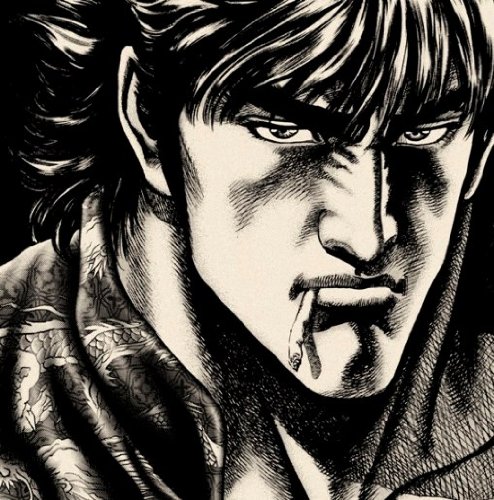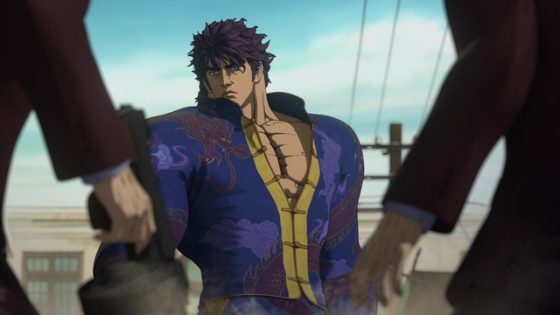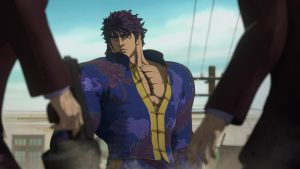
Though the recent season to Souten no Ken: Re:Genesis ended rather conclusively, the manga is still in serialization upon the drafting and initial uploading of this article. While they do share some significant differences, the basis of their plots are still the same. Souten no Ken takes place 60 years before Hokuto no Ken, when World War II is starting to break out, and it highlights some actual events and portrays some actual figures. The main character is Kenshiro Kasumi, an unassuming professor at a women’s university who is actually the master of Hokuto Shinken, a martial art that allows him to make people explode upon pressing a certain pressure point. Upon receiving a message from an old friend, he must go to Shanghai to save an old friend and a former lover, and from there, the outcome of the war slowly enters his hands.
Kenshiro’s portrayal
Kenshiro’s personality in both the anime and manga are pretty much the same though his journeys significantly diverge in both versions. Compared to his stoic nephew when he’s around people, the Kenshiro of this series has a very casual personality and has more of a sense of humor (and is a major chain smoker, which he says helps with his bleeding when he fights). Though the OG Kenshiro popularized man tears, the Kenshiro of Souten no Ken exhibits a wide variety of emotions in both versions and isn’t afraid of being friendly with those he cares about, or trash talking enemies for fun rather than just saying it for the sake that he’s going to kick their ass like it’s nothing. In addition, both the anime and manga version of Kenshiro share a unique sense of smell and retain their trademark lines such as “Ni yi jing si le” (aka Omae wa mou, shindeiru), or “monku ga areba, ore ni ie (if you got a problem, take it up with me)!” While Kenshiro suggestively dies at the end of the anime, his journey in the manga is still ongoing!
In addition to Kenshiro still being alive in the manga, at the start of the Re:Genesis anime, Pan, his best friend dies. However, he never died in the original manga but is just permanently disabled instead. In both versions, Yuling, his sister and Kenshiro’s girlfriend, still takes over the gang. Last, his mother is actually alive in the manga and she plays a role despite being non-existent in the anime.
Execution of the Action
What both the manga and anime also share in common in a foundational sense is how they portray the action. Though Hokuto no Ken, its respective predecessor emphasizes more on the gimmicky carnage and guts, the action in Souten no Ken largely focuses more on the technical aspects of the fighting like it’s a Kung Fu movie. Their movements appropriately reflect their muscular bodies where they are fast but execute certain punches and kicks that compliment their frames. If you don’t believe big guys like them can be agile, we encourage you watch some pro wrestling to get an idea that they can.
Removal of Characters
Kenshiro encounters many rivals throughout his journey, and some of them become significant allies upon losing to him. This is true with both Yasaka and Feiyan in the anime and manga. However, the anime criminally removes one significant rival such as Liu Zongwu, this series’ equivalent to Raoh/Kaioh from Hokuto no Ken. Like Kaioh, he is a master of another form of Hokuto’s martial arts which focuses on implosions as opposed to explosions. As weird as this sounds, Zongwu happens to be a Nazi soldier who is a Chinese (the Chinese in fact did have a brief semi-alliance with Germany before the war). However, he serves as Kenshiro’s greatest rival in the Souten no Ken manga and his removal from the anime just makes that version feel empty. Kenshin, Kenshiro’s rival in the anime, is a good character, but Zongwu as the Chinese Nazi is a more worthy villain. In connection to Zongwu and Ramon (who is Hokuto no Ken’s adopted father), the manga implies he was the teacher to Jukei, an old man the Hokuto no Ken Kenshiro meets in the final story arc, and uses the same fighting style as Zongwu. In the Souten no Ken manga, you see Jukei as a boy and he meets Zongwu after his redeems himself.
Final Thoughts

Last, what is interesting to note is how many actual historical figures played a role in the manga, and are entirely taken out of the anime (we assume it may be estate issues). One notable person is Chiang Kai-shek, a general in China’s army in World War II and a controversial right wing politician. On the Japanese side, we also have Iwane Matsui, a general largely responsible and executed for the Rape of Nanjing after World War II. However, the anime does manage to still feature Puyi, a former Emperor of China who became a puppet governor for the Japanese as the Emperor of Manchuko throughout World War II. As some of you may know, many Japanese politicians try to deny the nation’s aggressions in World War II. Thankfully, the manga nor the anime doesn’t promote that kind of agenda in regards to Japan’s sins in World War II, when in fact, it promotes them not only as fact, but wrong.
While both the anime and manga take place in World War II, the manga portrays a lot of the politics in some story arcs while the anime doesn’t emphasize them too much. By adding these historical figures, it does add more to the story and the outcome. Considering how the world of Hokuto no Ken is devastated by nuclear war, both versions do a great job of bringing out the irony that despite stopping the world from being entirely nuked, it ends up that way just sixty years later.



